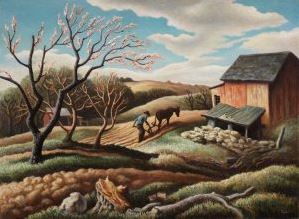Teaching Art
My blog topics, like my art lesson plans, usually start with inspiration. It can be something I've seen, places I've visited or want to visit, or an art topic I want to talk about or learn more about. With Blogspot, the first picture you choose becomes displayed as a thumbnail, along with the first few lines of text, when viewed from a smartphone. This enlargement project, commemorating Dr. King, was done by another Art Docent's class at an elementary school where I volunteered. The lesson was likely about value though I don't recall which artist was being taught. I try to align my projects with what the students may be studying or possibly the time of year (e.g. MLK in January).
I also relate my teaching experiences, classes I've taught, successful lessons, famous artists that have inspired me, and discussion of the elements and principles of art. These JFK collages by Robert Rauschenberg were used as examples in my Collage Portraits Class with seniors.
Travel
 |
| Scott Bakula & Richard Dean Anderson |
I almost always start with a personal story to connect to the topic. In a recent post about art in NW cities, I started off by relating the celebrity hockey game my brother and I saw while visiting Vancouver back in 1986.
 |
| Tom Seaver (1977) by Andy Warhol |
Observation: Making Connections
Every morning, I revisit the emerging blog post and add to what I already have. Many edits happen along the way. It's funny how many connections get made between the paragraphs. Relationships between the artists and subject matter also emerge as I read more about them. I begin to recall paintings I've seen before and include them for comparison. Even if I'm discovering new local or contemporary artists, I like to imagine which artists inspired them, and how their work is sometimes reminiscent of the masters who preceded them.
 |
| Selfportrait with Bandaged Ear (1889) |
This self-portrait of Van Gogh has one of his re-interpretations of a Japanese print hanging on the wall in the background. I hadn't noticed its significance before. Apparently, in another self-portrait, he even changed the shape of his eyes to look Japanese.
 |
| Self-Portrait with Yellow Christ (1889) |
In the same year, his friend, Gauguin painted a self-portrait with The Yellow Christ and Pot in the form of a Grotesque Head in the background.
More obvious is Italian Renaissance painter Sofonisba Anguissola's Self-portrait Painting the Madonna (1556). She's actually posed in front of her work like Norman Rockwell was in his triple self-portrait. Even in the 16th century, it paid to advertise!
 |
| Portrait of the Artist at His Easel (1660) |
Engaging in visual observation and having conversations about what you see can be entertaining and a great way to interact with people and surrounding art. You don't have to know about the art you're looking at to appreciate it, though it can lend understanding to learn more about it or the artist from museum personnel, bloggers, artbooks, or your own online research.
 |
| Elaine de Kooning with JFK Sketches and Paintings |
Portrait artists may need to become familiar with their subject before settling down to paint a serious final image. This was especially true for Gilbert Stuart, who kept an unfinished portrait of George Washington as a model for all future portraits of the 1st President.
Like drafts of a manuscript, sketches and studies help an artist practice their craft in a fluid and expressive manner that resembles a writer's stream of consciousness. Many artists, such as Picasso, Jackson Pollock, and Wassily Kandinsky created studies leading up to some of their most famous works. Such works were often numbered rather than giving them representative titles.
Visual Art Activities
I will often finish out the school year with a timeline of the artists we've studied. I created this collage of famous self-portraits to see how many of them my students could guess correctly. MS-PowerPoint allowed me to reveal them in order through the use of the animation capability.
When I started blogging, I would pull topics from something I had taught about. I hoped that other art docents would appreciate the topics about art elements and principles and also use some of my project ideas in their own lesson plans. I wanted to encourage participation in visual art activities.
Finishing Up
How do I know when I'm done? I like to share ~12-15 photos per blog. The size of each photo depends upon how much text there is describing it. Or the amount of text is edited down to fit adjacent to the picture. I try to arrange my photos alternating between left- and right-justified so that my article flows visually.
I have a couple of dedicated readers who suggest improvements and sometimes provide ideas for topics. Since I now have over 70 posts, and I haven't been teaching due to the pandemic, it would be helpful to get more suggestions. I hope to get the opportunity to do online teaching as students begin this challenging new era of online education.































































